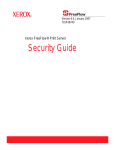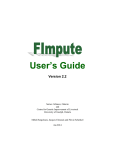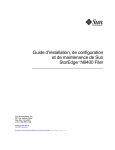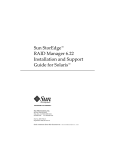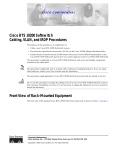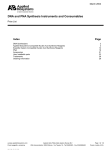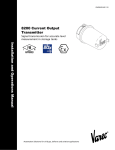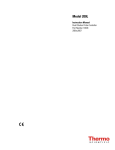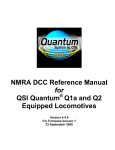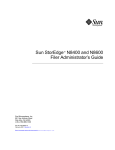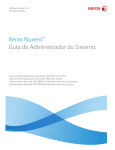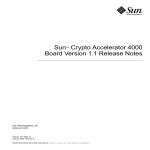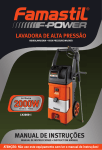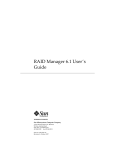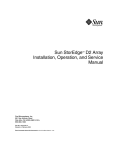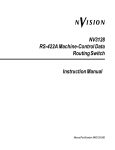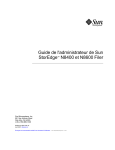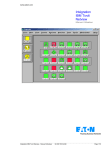Download Sun StorEdge N8200 Filer Service Manual
Transcript
Sun StorEdge™ N8200 Filer Service Manual Sun Microsystems, Inc. 901 San Antonio Road Palo Alto, CA 94303 U.S.A. 650-960-1300 Part No. 806-5418-11 August 2000, Revision A Send comments about this document to: [email protected] Copyright 2000 Sun Microsystems, Inc., 901 San Antonio Road • Palo Alto, CA 94303-4900 USA. All rights reserved. This product or document is protected by copyright and distributed under licenses restricting its use, copying, distribution, and decompilation. No part of this product or document may be reproduced in any form by any means without prior written authorization of Sun and its licensors, if any. Third-party software, including font technology, is copyrighted and licensed from Sun suppliers. Parts of the product may be derived from Berkeley BSD systems, licensed from the University of California. UNIX is a registered trademark in the U.S. and other countries, exclusively licensed through X/Open Company, Ltd. For Netscape Communicator™, the following notice applies: Copyright 1995 Netscape Communications Corporation. All rights reserved. Sun, Sun Microsystems, the Sun logo, docs.sun.com, Sun StorEdge, Sun Enterprise, Solstice DiskSuite, and Solaris are trademarks, registered trademarks, or service marks of Sun Microsystems, Inc. in the U.S. and other countries. All SPARC trademarks are used under license and are trademarks or registered trademarks of SPARC International, Inc. in the U.S. and other countries. Products bearing SPARC trademarks are based upon an architecture developed by Sun Microsystems, Inc. The OPEN LOOK and Sun™ Graphical User Interface was developed by Sun Microsystems, Inc. for its users and licensees. Sun acknowledges the pioneering efforts of Xerox in researching and developing the concept of visual or graphical user interfaces for the computer industry. Sun holds a non-exclusive license from Xerox to the Xerox Graphical User Interface, which license also covers Sun’s licensees who implement OPEN LOOK GUIs and otherwise comply with Sun’s written license agreements. RESTRICTED RIGHTS: Use, duplication, or disclosure by the U.S. Government is subject to restrictions of FAR 52.227-14(g)(2)(6/87) and FAR 52.227-19(6/87), or DFAR 252.227-7015(b)(6/95) and DFAR 227.7202-3(a). DOCUMENTATION IS PROVIDED “AS IS” AND ALL EXPRESS OR IMPLIED CONDITIONS, REPRESENTATIONS AND WARRANTIES, INCLUDING ANY IMPLIED WARRANTY OF MERCHANTABILITY, FITNESS FOR A PARTICULAR PURPOSE OR NONINFRINGEMENT, ARE DISCLAIMED, EXCEPT TO THE EXTENT THAT SUCH DISCLAIMERS ARE HELD TO BE LEGALLY INVALID. Copyright 2000 Sun Microsystems, Inc., 901 San Antonio Road • Palo Alto, CA 94303-4900 Etats-Unis. Tous droits réservés. Ce produit ou document est protégé par un copyright et distribué avec des licences qui en restreignent l’utilisation, la copie, la distribution, et la décompilation. Aucune partie de ce produit ou document ne peut être reproduite sous aucune forme, par quelque moyen que ce soit, sans l’autorisation préalable et écrite de Sun et de ses bailleurs de licence, s’il y en a. Le logiciel détenu par des tiers, et qui comprend la technologie relative aux polices de caractères, est protégé par un copyright et licencié par des fournisseurs de Sun. Des parties de ce produit pourront être dérivées des systèmes Berkeley BSD licenciés par l’Université de Californie. UNIX est une marque déposée aux Etats-Unis et dans d’autres pays et licenciée exclusivement par X/Open Company, Ltd. La notice suivante est applicable à Netscape Communicator™: Copyright 1995 Netscape Communications Corporation. Tous droits réservés. Sun, Sun Microsystems, the Sun logo, docs.sun.com, Sun StorEdge, Sun Enterprise, Solstice DiskSuite, et Solaris sont des marques de fabrique ou des marques déposées, ou marques de service, de Sun Microsystems, Inc. aux Etats-Unis et dans d’autres pays. Toutes les marques SPARC sont utilisées sous licence et sont des marques de fabrique ou des marques déposées de SPARC International, Inc. aux Etats-Unis et dans d’autres pays. Les produits portant les marques SPARC sont basés sur une architecture développée par Sun Microsystems, Inc. L’interface d’utilisation graphique OPEN LOOK et Sun™ a été développée par Sun Microsystems, Inc. pour ses utilisateurs et licenciés. Sun reconnaît les efforts de pionniers de Xerox pour la recherche et le développement du concept des interfaces d’utilisation visuelle ou graphique pour l’industrie de l’informatique. Sun détient une licence non exclusive de Xerox sur l’interface d’utilisation graphique Xerox, cette licence couvrant également les licenciés de Sun qui mettent en place l’interface d’utilisation graphique OPEN LOOK et qui en outre se conforment aux licences écrites de Sun. CETTE PUBLICATION EST FOURNIE "EN L’ETAT" ET AUCUNE GARANTIE, EXPRESSE OU IMPLICITE, N’EST ACCORDEE, Y COMPRIS DES GARANTIES CONCERNANT LA VALEUR MARCHANDE, L’APTITUDE DE LA PUBLICATION A REPONDRE A UNE UTILISATION PARTICULIERE, OU LE FAIT QU’ELLE NE SOIT PAS CONTREFAISANTE DE PRODUIT DE TIERS. CE DENI DE GARANTIE NE S’APPLIQUERAIT PAS, DANS LA MESURE OU IL SERAIT TENU JURIDIQUEMENT NUL ET NON AVENU. Please Recycle Contents Preface ix Reference Documentation 1. Filer Overview 2. Software Differences xi 13 15 Sun Enterprise 220R Server Differences as Configured for Use in the Filer New Software Packages 16 Modified Filer Performance Software Moved Files 16 17 New Directories 18 Explanation of the N8000 Directory Structure New Factory Scripts New Patches 3. Troubleshooting 16 18 19 19 21 The Console Connection Does Not Come Up 22 On First Boot, Error Messages Are Displayed and the System Will Not Boot 22 The Filer Administration Tool Does Not Open 24 The Filer Administration Tool Does Not Display Properly 24 Contents iii Cannot Ping the Filer on the Network 24 The Web Browser Displays the Message: The requested item could not be loaded by the proxy 26 A Data Disk in a Disk Storage Unit Fails A Boot Disk in the Controller Fails 27 27 Disk Storage Unit Hot Spare Operation 28 Long Reboot Time After Fixing a Controller Boot Disk Failure 28 You Cannot Access Data on a Disk Storage Unit and the Amber LED on the Unit Is Lit 29 Failure in the Controller Power Supply or Fan 30 Failure in the Disk Storage Unit Power Supply or Cooling Canister 4. Recovery Software Instructions ▼ 31 To Boot the System With the Filer Recovery CD Partitioning the Boot Disk 30 32 33 ▼ To Use the format Command to Partition the Boot Disk 33 ▼ To Use the newfs Command to Create a File System on the Root Slice of the Boot Disk 39 ▼ To Restore From the Filer Recovery CD ▼ To Enable the Mounting of the Disk Arrays ▼ To Mirror the Internal Disks Using the Sun Solstice DiskSuite Software 40 41 Contents 43 iv Figures FIGURE 1-1 Typical N8200 Network Configuration FIGURE 3-1 SCSI Connections Between Controller and Disk Storage Units FIGURE 3-2 Back of Disk Storage Unit 14 23 29 Figures v vi Sun StorEdge N8200 Filer Service Manual • August 2000 Tables TABLE 2-1 Modified Files 16 TABLE 2-2 Added Directories 18 TABLE 2-3 Directory Structure Explanation 18 TABLE 2-4 New Factory Scripts 19 Tables vii viii Sun StorEdge N8200 Filer Service Manual • August 2000 Preface The Sun StorEdge N8200 Filer Service Manual describes the modifications to the Sun Enterprise™ 220R Server adapted for use in the Sun StorEdge™ N8200 filer (hereafter referred to as “the filer”). This document also provides troubleshooting information, a controller boot disk recovery procedure, and some minor maintenance procedures for the filer. The intended audience of the manual is Sun service providers. Do not allow a customer to acquire this manual. How This Book Is Organized Chapter 1 provides a product overview. Chapter 2 describes the software differences made to the Sun Enterprise 220R Server to customize it for adaptation to the filer. Chapter 3 gives troubleshooting procedures for the filer. Chapter 4 provides instructions for using the Sun StorEdge Filer Recovery Software (“filer recovery CD) to recover the filer. ix Typographic Conventions Typeface Meaning Examples AaBbCc123 The names of commands, files, and directories; on-screen computer output Edit your .login file. Use ls -a to list all files. % You have mail. AaBbCc123 What you type, when contrasted with on-screen computer output % su Password: AaBbCc123 Book titles, new words or terms, words to be emphasized Read Chapter 6 in the User’s Guide. These are called class options. You must be superuser to do this. Command-line variable; replace with a real name or value To delete a file, type rm filename. Shell Prompts x Shell Prompt C shell machine_name% C shell superuser machine_name# Bourne shell and Korn shell $ Bourne shell and Korn shell superuser # Sun StorEdge N8200 Filer Service Manual • August 2000 Reference Documentation Document TItle Part Number Sun StorEdge N8200 Filer Release Notes 806-5419 Sun StorEdge N8200 Filer Installation, Configuration, and Service Guide 806-4668 Sun StorEdge N8200 Filer Installation Checklist 806-5417 Sun StorEdge N8000 Filer Series Administrator’s Guide 806-4669 Sun StorEdge A1000 and D1000 Installation, Operations, and Service Manual 805-2624 Sun Enterprise 220R Server Setup and Rackmounting Guide 806-1087 Sun Solstice DiskSuite 4.2 User’s Guide 805-5961 Sun StorEdge N8200 Filer Recovery Software 804-7320 Accessing Sun Documentation Online The docs.sun.comsm web site enables you to access Sun technical documentation on the Web. You can browse the docs.sun.com archive or search for a specific book title or subject at: http://docs.sun.com Ordering Sun Documentation Fatbrain.com, an Internet professional bookstore, stocks select product documentation from Sun Microsystems, Inc. For a list of documents and how to order them, visit the Sun Documentation Center on Fatbrain.com at: http://www1.fatbrain.com/documentation/sun Preface xi Sun Welcomes Your Comments Sun is interested in improving its documentation and welcomes your comments and suggestions. You can email your comments to Sun at: [email protected] Please include the part number (806-5418-11) of your document in the subject line of your email. xii Sun StorEdge N8200 Filer Service Manual • August 2000 CHAPTER 1 Filer Overview A network attached storage (NAS) device is an appliance that supplies disk storage to users over a network. Moving storage from the user’s desktop to the network maximizes data availability and security. The Sun StorEdge N8200 Filer (hereafter referred to as “the filer”) is a NAS that consists of a controller and one or more disk storage systems (hereafter referred to as “disk storage unit”). The filer contains features that are designed to minimize down time, including: ■ Mirrored system disks in the controller ■ Hardware redundant array of independent disks (RAID)-5 storage system ■ Redundant power supplies in both the controller and disk storage units Access to the filer’s disk storage is through the following industry standard file access protocols: ■ NFS™ file system ■ Common Internet File System (CIFS) 13 The filer includes a web-based administration tool that provides an easy-to-use graphical user interface (GUI). FIGURE 1-1 illustrates how a filer can interact in a common network environment. Microsoft Windows host UNIX host Network SCSI cable N8200 filer Controller Disk storage Linux host Disk storage Disk storage Disk storage FIGURE 1-1 Typical N8200 Network Configuration Note – The N8200 filer system storage can be expanded in 200-Gbyte increments to a maximum of 800 Gbytes. This is done by adding disk storage units. Contact your local Sun sales representative for more information. 14 Sun StorEdge N8200 Filer Service Manual • August 2000 CHAPTER 2 Software Differences The Solaris operating environment contained in the Sun Enterprise 220R Server has been tuned to optimize performance for NFS and I/O operations. Some Solaris services that are not necessary for the filer have been disabled, making the filer more secure. This chapter provides detailed information on modifications and additions to the Solaris operating environment and is organized as follows: ■ “Sun Enterprise 220R Server Differences as Configured for Use in the Filer” on page 16 ■ “New Software Packages” on page 16 ■ “Modified Filer Performance Software” on page 16 ■ “Modified Files” on page 16 ■ “Moved Files” on page 17 ■ “New Directories” on page 18 ■ “Explanation of the N8000 Directory Structure” on page 18 ■ “New Factory Scripts” on page 19 ■ “New Patches” on page 19 15 Sun Enterprise 220R Server Differences as Configured for Use in the Filer New Software Packages These packages have been added to the filer: ■ RAID Manager 6.22 ■ Solstice DiskSuite™ 4.2 ■ Sun Gigabit Ethernet 2.0 Drivers Modified Filer Performance Software The goal of the modified software is to: ■ Tune the system to be fully compatible with hosts running on the NFS™ and the Common Internet File System (CIFS) ■ Provide a graphical user interface (GUI) for system management tasks ■ Streamline operations by having unnecessary services and scripts disabled Modified Files The following files have been modified. TABLE 2-1 16 Modified Files File Name Explanation /etc/system Contains tuning for the system. /etc/motd Adds a message that says, ’this is a sunfiler’ so that service personnel knows it is a sunfiler if they login via telnet. /etc/vfstab Since it is pre configured, this file includes the preconcerted file systems. /etc/nologin Disables non-root logins. Sun StorEdge N8200 Filer Service Manual • August 2000 TABLE 2-1 Modified Files (Continued) File Name Explanation /etc/inttab Respawn entry added for web management GUI. /etc/rc2.d/ S05RMTMPFILE Prevents /etc/nologin from being removed. /etc/rc2.d/S69inet Sleep added to get router discovery to work. /etc/rc3.d/ S15nfsd.server Script modified to always act as an NFS server. Also increases the number of nfsd threads. /usr/lib/osa/bin/ rmscript Enables errors to be emailed to people that are set up using the Filer Administration Tool, Settings function. /etc/services Un-needed services are disabled. /etc/inetd.conf Un-needed services are disabled. Moved Files The following files have been moved from the /etc/rc2.d directory to the /usr/ local/N8000/old directory. S47asppp S80PRESERVE S92volmgt S80lp S91afbinit S99tsquantum S89bdconfig S99dtlogin S85power S99audit S72autoinstall S93cacheos.finish S70uucp S80spc Chapter 2 Software Differences 17 New Directories TABLE 2-2 Added Directories Directory Explanation /usr/local/apache Apache 1.3.6 web server /usr/local/N8000/old Sun StorEdge N8200 filer files Explanation of the N8000 Directory Structure TABLE 2-3 18 Directory Structure Explanation Directory Explanation /usr/local/N8000/cfg/ Contains an email file that lists the email addresses that will be notified in case of a hardware failure, and has a filer file that contains the configuration settings. /usr/local/N8000/ classes/ Contains the jar file for the daemon running on the filer. /usr/local/N8000/old/ Contains the removed startup scripts. /usr/local/N8000/ scripts/ Contains various scripts used to configure and set up the Sun StorEdge N8000 filer in the factory (see TABLE 2-4). Do not use these scripts unless you are directed to do so. Sun StorEdge N8200 Filer Service Manual • August 2000 New Factory Scripts Do not use these scripts unless you are directed to do so. TABLE 2-4 New Factory Scripts Script Name Explanation mirror_cfg.sh Provides the setup of the root disks for mirroring. mirror_chk.sh Checks the mirror every hour and emails the users you have specified if there is an error. The script is run by cron. S99onetime Sets autoboot to true after first reboot. S99resync Synchronizes the root disks. system_chk.sh Tests filer daemon connectivity. ship_settings.sh Prepares the system for shipment, sets a number of log files to zero, and unconfigures the system. New Patches The following patch IDs have been added in addition to the patches installed with the Solaris 7 operating environment (dated November 1999). 106541-09 106924-05 107473-04 107458-06 107460-04 107469-05 108482-01 107148-06 107171-05 108301-01 108662-01 Chapter 2 Software Differences 19 20 Sun StorEdge N8200 Filer Service Manual • August 2000 CHAPTER 3 Troubleshooting This chapter provides the troubleshooting procedures for problems that might be encountered while using the Filer Administration Tool. This chapter is organized as follows: ■ “No Indication of a Console Connection Is Provided” on page 22 ■ “On First Boot, Error Messages Are Displayed and the System Will Not Boot” on page 22 ■ “The Filer Administration Tool Does Not Open” on page 24 ■ “The Filer Administration Tool Does Not Display Properly” on page 24 ■ “Cannot Ping the Filer on the Network” on page 24 ■ “The Web Browser Displays the Message: The requested item could not be loaded by the proxy” on page 26 ■ “A Data Disk in a Disk Storage Unit Fails” on page 27 ■ “A Boot Disk in the Controller Fails” on page 27 ■ “Disk Storage Unit Hot Spare Operation” on page 28 ■ “Long Reboot Time After Fixing a Controller Boot Disk Failure” on page 28 ■ “You Cannot Access Data on a Disk Storage Unit and the Amber LED on the Unit Is Lit” on page 29 ■ “Failure in the Controller Power Supply or Fan” on page 30 ■ “Failure in the Disk Storage Unit Power Supply or Cooling Canister” on page 30 21 No Indication of a Console Connection Is Provided The ok prompt is not displayed and there is no output. 1. Ensure that you are using the correct cables. Are you using the NULL modem cable that comes with the filer in the serial port A on the back of the controller? 2. Check the system configuration settings recorded in the Sun StorEdge N8200 Filer Installation, Configuration, and Service Guide. On First Boot, Error Messages Are Displayed and the System Will Not Boot 1. Ensure that the proper cables are used and that the cable connections are correct. The disk storage SCSI cable must not go to the onboard SCSI port on the lower left of the back of the controller. It must go to SCSI ports 1 through 4 on the right side. See FIGURE 3-1. 2. Log in as the root user by typing: # sys-unconfig 3. Type Yes when the following prompt is displayed: # Verify to execute card 4. When you see the ok prompt, power off the system. 5. Correct any cabling errors. 6. Ensure the disk storage unit(s) are powered on and no amber lights are lit, then and reboot the system. 22 Sun StorEdge N8200 Filer Service Manual • August 2000 Controller ON BOARD SCSI Disk Storage Unit 1* Disk Storage Unit 3* Disk Storage Unit 2* Disk Storage Unit 4* * Numbered by order of installation (see text) FIGURE 3-1 SCSI Connections Between Controller and Disk Storage Units Chapter 3 Troubleshooting 23 The Filer Administration Tool Does Not Open The web browser shows a gray box and the login dialog box is not displayed. 1. Make sure you are using the Netscape 4.x web browser. 2. Ensure that the Java™ language is enabled within the Netscape browser. 3. Bring up the Java console to check for any error messages. The Filer Administration Tool Does Not Display Properly ● Make sure you are using the Netscape 4.x web browser. Cannot Ping the Filer on the Network 1. Check to make sure you can ping other hosts on the network. 2. Verify the filer network cable is properly connected. 3. Check the network with the console connection. a. Connect the serial cable to the filer. b. Log in as a root user. If no login prompt is displayed, go to “No Indication of a Console Connection Is Provided” on page 22. c. Try to ping any host on the network. If you can ping another host, a problem exists with the network. d. Check to see if the filer can see traffic on the network by typing: # snoop -d hme0 Where hme0 is the network device. If nothing is displayed on the screen, verify again that the cable connections are correct. Note – No indicated traffic means that the interface is not connected to the network. 24 Sun StorEdge N8200 Filer Service Manual • August 2000 e. Type: # ifconfig -a The output should look something like the following: lo0: flags=849<UP,LOOPBACK.RUNNING, MULTICAST>mtu 8232 inet 127.0.0.1 netmask ff000000 hme0:flags=863<UP,BROADCAST,NOTRAILERS,RUNNING,MULTICAST> mtu 1500 inet 192.1.1.1 netmask ffffff00 broadcast 192.1.1.255 f. Verify that the following settings are correct: ■ ■ ■ IP address Broadcast address Flags g. If any setting is incorrect, do the following: i. Type: # vi /etc/hosts ii. Search the file to locate the filer IP address, which should be immediately below the local host IP address. 127.0.7.1 localhost name 192.130.151.22 filername loghost name iii. Correct the filername IP address. iv. Reboot by typing: # init 6 The broadcast address and interface flags are automatically corrected. Chapter 3 Troubleshooting 25 The Web Browser Displays the Message: The requested item could not be loaded by the proxy 1. Make sure that the URL address requested is correct and complete (IP address:8080). 2. Verify that the web server software is running by establishing a telnet connection to the filer from another host and typing: # ps -ef|grep httpd The output should look something like the following: # # # # # # # 26 nobody 4298 nobody 4306 root 4296 1 nobody 4302 nobody 4301 nobody 4300 nobody 4299 4296 0 Apr 4296 0 Apr 0 Apr 24 ? 4296 0 Apr 4296 0 Apr 4296 0 Apr 4296 0 Apr 24 ? 0:00/usr/local/apache/bin/http 24 ? 0:00/usr/local/apache/bin/http 0:00/usr/local/apache/bin/http 24 ? 0:00/usr/local/apache/bin/http 24 ? 0:00/usr/local/apache/bin/http 24 ? 0:00/usr/local/apache/bin/http 24 ? 0:00/usr/local/apache/bin/http ■ If the http processes are not displayed, re-start the web server. ■ If the http processes are displayed and the problem persists, carefully verify the URL address again. Sun StorEdge N8200 Filer Service Manual • August 2000 A Data Disk in a Disk Storage Unit Fails This failure is reported in three ways: ■ An amber LED on the disk drive lights ■ You receive an SNMP trap message ■ An email message sent to the address established with the Settings function. Refer to Sun StorEdge N8000 Series Filer Administrator’s Guide, Chapter 3, in the “To Change Email Notifications” section. Note – If only one disk drive fails in a disk storage unit, no data is lost and the operation of the unit is not interrupted. ● Replace the disk drive by following the instructions in Sun StorEdge A1000 and D1000 Installation, Operations, and Service Manual. The failed disk data is automatically reconstructed on the new disk. You do not have to reboot the system. A Boot Disk in the Controller Fails You are notified of this failure by an email message sent to the address established with the Settings function. Refer to Sun StorEdge N8000 Series Filer Administrator’s Guide, Chapter 3, in the “To Change Email Notifications” section. 1. Use the metadb command to remove the replica database from the failed drive. Refer to Sun Solstice DiskSuite 4.2 User’s Guide section: “How to Remove State Database Replicas (Command Line).” 2. If necessary, replace the failed disk drive. 3. Rebuild the mirror as required. Refer to Sun Solstice DiskSuite 4.2 User’s Guide for instructions. 4. Use the metadb command to create a new replica database on the replacement drive. Refer to Sun Solstice DiskSuite 4.2 User’s Guide for instructions. Note – The instructions to recover from a boot device failure are also located online at: http://docs.sun.com. You do not have to reboot the system. Chapter 3 Troubleshooting 27 Disk Storage Unit Hot Spare Operation A hot spare is an extra data disk used in the event of a failure of one of the data disks in a disk storage unit. If a data disk in a disk storage unit fails, the unit enters a degraded mode until all of the data on the failed disk is re-created on the hot spare. This process typically takes between one and two hours. The hot spare disk in the disk storage unit is in the right-most drive slot and is labeled “1,5”. If a data disk fails, the hot spare becomes active. If then an active hot spare fails, you are notified of this failure in three ways: ■ An amber LED on the disk drive goes bright ■ An SNMP trap message is sent ■ An email message sent to the address established with the Settings function. Refer to Sun StorEdge N8000 Series Filer Administrator’s Guide, Chapter 3, section “To Change Email Notifications.” If an inactive hot spare fails, the only way to detect the failure is to issue a healthchk command from the console. The procedure for replacing a hot spare is identical to replacing a data disk. Refer to “A Data Disk in a Disk Storage Unit Fails” on page 27. Long Reboot Time After Fixing a Controller Boot Disk Failure The filer is designed to have a fast reboot time due to a logging file system. The file system consistency check (fsck) time should be no more than 10 seconds. If it takes longer than 10 seconds: 1. Check the console attached to the system to see what is happening to the system. If you see no output and a lot of disk activity (the green LEDs on the disk drives are blinking), the system is working. Wait until it is finished. 2. Check to see if the system has been modified by altering the mount options in the /etc/vfstab file. 28 Sun StorEdge N8200 Filer Service Manual • August 2000 You Cannot Access Data on a Disk Storage Unit and the Amber LED on the Unit Is Lit Disk storage unit controller fault LED x FIGURE 3-2 y Back of Disk Storage Unit This can be due to two possible causes: ■ The SCSI cable is loose, or it is the wrong cable for the unit. ■ The disk storage unit controller has failed. If this happens, the data on the disks is still intact, but you must replace the disk storage unit controller. Replace the controller using the instructions in Sun StorEdge A1000 and D1000 Installation, Operations, and Service Manual. Make sure you reboot the system after replacing the controller. Caution – Make sure the memory in the new controller is the same as the original. Remove the memory from the old controller and install it in the new controller if necessary. You do not have to reconfigure the new controller. Chapter 3 Troubleshooting 29 Failure in the Controller Power Supply or Fan The cooling fan is integral to proper operation of the power supplies in the controller. This failure is reported in two ways: ■ Error messages in the /var/adm/messages file ■ An amber LED on the front of the controller lights See the replacement instructions in Sun StorEdge A1000 and D1000 Installation, Operations, and Service Manual. Failure in the Disk Storage Unit Power Supply or Cooling Canister The cooling fans and power supplies are individual parts of the disk storage unit. This failure is reported in four ways: ■ An SNMP trap message is sent ■ Error messages are printed to the /var/adm/messages file ■ An amber LED on the front of the disk storage unit lights ■ An amber LED on the power supply or cooling canister lights See the replacement instructions in Sun StorEdge A1000 and D1000 Installation, Operations, and Service Manual. 30 Sun StorEdge N8200 Filer Service Manual • August 2000 CHAPTER 4 Recovery Software Instructions This chapter describes how use the Sun StorEdge N8200 Filer Recovery Software (hereafter referred to as “filer recovery CD”) to recover the Sun StorEdge N8200 filer. The filer recovery CD is a bootable CD-ROM with a complete image of the Sun StorEdge N8200 filer system disk, including the Solaris operating environment, RAID Manager 6.2.2, Solstice DiskSuite 4.2, Sun StorEdge N8200 filer Performance Software, and all required patches and tuning. This is a disaster-recovery procedure. This procedure should be used only in the event that the internally mirrored system disks have both suffered a failure. This procedure resets the system (excluding the data contained on the attached storage arrays) to a factory-configured state. There are six steps to the recovery process: ■ “To Boot the System With the Filer Recovery CD” on page 32 ■ “To Use the format Command to Partition the Boot Disk” on page 33 ■ “To Use the newfs Command to Create a File System on the Root Slice of the Boot Disk” on page 39 ■ “To Restore From the Filer Recovery CD” on page 40 ■ “To Enable the Mounting of the Disk Arrays” on page 41 ■ “To Mirror the Internal Disks Using the Sun Solstice DiskSuite Software” on page 43 31 ▼ To Boot the System With the Filer Recovery CD This procedure performs an initial boot of the hard disk in the controller. 1. Insert the filer recovery CD into the CD-ROM drive. 2. Boot from the CD using the appropriate boot device name for the CD-ROM by typing: ok boot cdrom The following typical output is displayed. Resetting ... screen not found Can’t open input device Keyboard not present. Using ttya for input and output StorEdge(TM) N8200 filer (2 X UltraSPARC-II 450MHz), No Keyboard OpenBoot 3.23, 2048 MB memory installed, Serial #11823569 Ethernet address 8:0:20:b4:69:d1, Host ID: 80b469d1 Rebooting with command: boot cdrom Boot device: /pci@1f,4000/scsi@3/disk@6,0:f File and args: SunOS Release 5.7 Version Generic [UNIX(R) System V Release 4.0] Copyright (c) 1983-1998, Sun Microsystems, Inc. Configuring devices... # At this point you might be able to recover some data from the failed system disks by temporarily mounting the “failed” system disks to determine what data, if any, might be recovered. The critical files to look for include: ■ ■ ■ ■ ■ 32 /etc/passwd /etc/shadow /etc/group /etc/inet/hosts /etc/dfs/dfstab Sun StorEdge N8200 Filer Service Manual • August 2000 Partitioning the Boot Disk It is critical to partition the boot disk as described below. Failure to do so could create problems later in the recovery process. This section has two basic steps: ▼ ■ “To Use the format Command to Partition the Boot Disk” on page 33 ■ “To Use the newfs Command to Create a File System on the Root Slice of the Boot Disk” on page 39 To Use the format Command to Partition the Boot Disk 1. Create slice 0 starting at cylinder 0, 3 Gbytes in size, by typing: # format The following typical output is displayed. Searching for disks...done AVAILABLE DISK SELECTIONS: 0. c0t0d0 <SUN9.0G cyl 4924 alt 2 hd 27 sec 133> /pci@1f,4000/scsi@3/sd@0,0 1. c0t1d0 <SUN9.0G cyl 4924 alt 2 hd 27 sec 133> /pci@1f,4000/scsi@3/sd@1,0 2. c1t5d0 <Symbios-StorEDGEA1000-0301 cyl 47393 alt 2 hd 128 sec 64> /pci@1f,2000/scsi@1/sd@5,0 Specify disk (enter its number): a. Type 0. Chapter 4 Recovery Software Instructions 33 The following typical output is displayed. selecting c0t0d0 [disk formatted] FORMAT MENU: disk type partition current format repair label analyze defect backup verify save inquiry volname !<cmd> quit format> - select a disk - select (define) a disk type - select (define) a partition table - describe the current disk - format and analyze the disk - repair a defective sector - write label to the disk - surface analysis - defect list management - search for backup labels - read and display labels - save new disk/partition definitions - show vendor, product and revision - set 8-character volume name - execute <cmd>, then return b. Type p. The following typical output is displayed. PARTITION MENU: 0 1 2 3 4 5 6 7 select modify name print label !<cmd> quit partition> - change ‘0’ partition change ‘1’ partition change ‘2’ partition change ‘3’ partition change ‘4’ partition change ‘5’ partition change ‘6’ partition change ‘7’ partition select a predefined table modify a predefined partition table name the current table display the current table write partition map and label to the disk execute <cmd>, then return c. Type 0. 34 Sun StorEdge N8200 Filer Service Manual • August 2000 The following typical output is displayed. Part Tag Flag Cylinders 0 unassigned wm 0 57 Enter partition id tag[unassigned]: Size 101.70MB Blocks (58/0/0) 208278 d. Type root. The following typical output is displayed. Enter partition permission flags[wm]: e. Type wm. The following typical output is displayed. Enter new starting cyl[0]: f. Type 0. The following typical output is displayed. Enter partition size[208278b, 58c, 101.70mb, 0.10gb]: g. Type 3g. The following typical output is displayed. partition> h. Type p. Chapter 4 Recovery Software Instructions 35 The following typical output is displayed. Current partition table (unnamed): Total disk cylinders available: 4924 + 2 (reserved cylinders) Part Tag Flag Cylinders Size Blocks 0 root wm 0 - 1752 3.00GB (1753/0/0) 6295023 1 swap wm 58 - 152 166.57MB (95/0/0) 341145 2 unassigned wm 0 - 4923 8.43GB (4924/0/0) 17682084 3 unassigned wm 0 0 (0/0/0) 4 unassigned wm 0 0 (0/0/0) 5 unassigned wm 0 0 (0/0/0) 6 unassigned wm 0 0 (0/0/0) 7 unassigned wm 0 0 (0/0/0) partition> 2. Create slice 1 swap, starting where Slice 0 leaves off, 2 Gbytes in size. a. Type 1. The following typical output is displayed. Part Tag Flag Cylinders 1 swap wm 58 - 152 Enter partition id tag[swap]: Size 166.57MB b. Type swap. The following typical output is displayed. Enter partition permission flags[wm]: c. Type wu. The following typical output is displayed. Enter new starting cyl[58]: d. Type 1753. The following typical output is displayed. Enter partition size[341145b, 95c, 166.57mb, 0.16gb]: 36 Sun StorEdge N8200 Filer Service Manual • August 2000 Blocks (95/0/0) 341145 0 0 0 0 0 e. Type 2g. The following typical output is displayed. partition> 3. Create slice 7 metadb, 1 cylinder in size, starting at the last cylinder of the drive. a. Type 7. The following typical output is displayed. Part Tag Flag Cylinders 7 unassigned wm 0 Enter partition id tag[unassigned]: Size 0 Blocks (0/0/0) 0 b. Type unassigned. The following typical output is displayed. Enter partition permission flags[wm]: c. Type wu. The following typical output is displayed. Enter new starting cyl[58]: d. Type 4923. The following typical output is displayed. Enter partition size[341145b, 95c, 166.57mb, 0.16gb]: e. Type 1c. The following typical output is displayed. partition> f. Type p. Chapter 4 Recovery Software Instructions 37 The following typical output is displayed. Current partition table (unnamed): Total disk cylinders available: 4924 + 2 (reserved cylinders) Part Tag Flag Cylinders Size Blocks 0 root wm 0 - 1752 3.00GB (1753/0/0) 6295023 1 swap wu 1753 - 2921 2.00GB (1169/0/0) 4197879 2 unassigned wm 0 - 4923 8.43GB (4924/0/0) 17682084 3 unassigned wm 0 0 (0/0/0) 4 unassigned wm 0 0 (0/0/0) 5 unassigned wm 0 0 (0/0/0) 6 unassigned wm 0 0 (0/0/0) 7 unassigned wu 4923 - 4923 1.75MB (1/0/0) 3591 partition> g. Type 1. The following typical output is displayed. Ready to label disk, continue? h. Type y. The following typical output is displayed. partition> i. Type q. 38 Sun StorEdge N8200 Filer Service Manual • August 2000 0 0 0 0 The following typical output is displayed. FORMAT MENU: disk type partition current format repair label analyze defect backup verify save inquiry volname !<cmd> quit format> - select a disk - select (define) a disk type - select (define) a partition table - describe the current disk - format and analyze the disk - repair a defective sector - write label to the disk - surface analysis - defect list management - search for backup labels - read and display labels - save new disk/partition definitions - show vendor, product and revision - set 8-character volume name - execute <cmd>, then return j. Type q. ▼ To Use the newfs Command to Create a File System on the Root Slice of the Boot Disk 1. Type: # newfs /dev/rdsk/c0t0d0s0 The following typical output is displayed. newfs: construct a new file system /dev/rdsk/c0t0d0s0: (y/n)? 2. Type y. Chapter 4 Recovery Software Instructions 39 The following typical output is displayed. /dev/rdsk/c0t0d0s0: 6295022 sectors in 1753 cylinders of 27 tracks, 133 sectors 3073.7MB in 110 cyl groups (16 c/g, 28.05MB/g, 3392 i/g) super-block backups (for fsck -F ufs -o b=#) at: 32, 57632, 115232, 172832, 230432, 288032, 345632, 403232, 460832, 518432, 576032, 633632, 691232, 748832, 806432, 864032, 921632, 979232, 1036832, 1094432, 1152032, 1209632, 1267232, 1324832, 1382432, 1440032, 1497632, 1555232, 1612832, 1670432, 1728032, 1785632, 1838624, 1896224, 1953824, 2011424, 2069024, 2126624, 2184224, 2241824, 2299424, 2357024, 2414624, 2472224, 2529824, 2587424, 2645024, 2702624, 2760224, 2817824, 2875424, 2933024, 2990624, 3048224, 3105824, 3163424, 3221024, 3278624, 3336224, 3393824, 3451424, 3509024, 3566624, 3624224, 3677216, 3734816, 3792416, 3850016, 3907616, 3965216, 4022816, 4080416, 4138016, 4195616, 4253216, 4310816, 4368416, 4426016, 4483616, 4541216, 4598816, 4656416, 4714016, 4771616, 4829216, 4886816, 4944416, 5002016, 5059616, 5117216, 5174816, 5232416, 5290016, 5347616, 5405216, 5462816, 5515808, 5573408, 5631008, 5688608, 5746208, 5803808, 5861408, 5919008, 5976608, 6034208, 6091808, 6149408, 6207008, 6264608, 3. Mount the root slice of the boot disk by typing: # mount /dev/dsk/c0t0d0s0 /mnt ▼ To Restore From the Filer Recovery CD 1. Change the working directory to correspond to the root slice of the boot disk by typing: # cd /mnt 2. Verify the name of the image that will be restored from the filer recovery CD by typing: # ls -l /cdrom/img 40 Sun StorEdge N8200 Filer Service Manual • August 2000 The following typical output is displayed. total 789576 -rw------1 root other 404262708 May 3 11:13 gd050300.dmp.Z 3. Using the zcat and ufsrestore commands, restore from the filer recovery CD to the current directory by typing: # zcat /cdrom/img/gd050300.dmp | ufsrestore -rf - The following typical output is displayed. Warning: ./lost+found: File exists 4. Using the installboot command, install a boot block on the root slice of the boot disk by typing: # installboot /usr/platform/sun4u/lib/fs/ufs/bootblk /dev/rdsk/c0t0d0s0 5. Reboot the system to proceed to the next step by typing: # reboot The following typical output is displayed. syncing file systems... done rebooting... Resetting ... ▼ To Enable the Mounting of the Disk Arrays After performing a reboot as described in “To Restore From the Filer Recovery CD” on page 40, you must provide some values to answer configuration questions to complete the Solaris installation process. During an initial build, these values are temporary, because the system is reset using the sys-unconfig command prior to shipment. During a rebuild, these values are customer-assigned. Chapter 4 Recovery Software Instructions 41 1. Provide answers to system prompts to answer Solaris configuration questions. Check the system configuration settings you recorded in the Sun StorEdge N8200 Filer Installation Guide or the Sun StorEdge N8200 Filer Installation Checklist. The following typical output is displayed after answering the last prompt. rebooting ... Resetting ... screen not found Can’t open input device Keyboard not present. Using ttya for input and output StorEdge(TM) N8200 filer (2 X UltraSPARC-II 450MHz), No Keyboard OpenBoot 3.23, 2048 MB memory installed, Serial #11823569 Ethernet address 8:0:20:b4:69:d1, Host ID: 80b469d1 Rebooting with command: boot Boot device: disk File and args: SunOS Release 5.7 Version Generic_106541-10 64-bit [UNIX(R) System V Release 4.0] Copyright (c) 1983-1999, Sun Microsystems, Inc. configuring network interfaces: hme0. Hostname: sunfiler metainit: sunfiler: there are no existing databases The system is coming up. Please wait. Sun Microsystems Inc. SunOS 5.7 Generic October 1998 This system has been configured as a Sun StorEdge(TM) N8200 filer, please refer to the N8000 filer series Administrator’s Guide for details. The system is ready. sunfiler console login: 2. Log into the N8200 filer as the super-user root by typing: root The following typical output is displayed. password: 3. Type password. The following typical output is displayed. Last login: Thu May 4 11:03:24 on console Sun Microsystems Inc. SunOS 5.7 Generic October 1998 This system has been configured as a Sun StorEdge(TM) N8200 filer, please refer to the N8000 filer series Administrator’s Guide for details. 42 Sun StorEdge N8200 Filer Service Manual • August 2000 4. Start the vi editor and access the /etc/vfstab file by typing: # vi /etc/vfstab 5. Edit the /etc/vfstab file by adding entries to mount the customer’s storage arrays. Make sure you configure the mounts to automatically mount at boot time and enable the logging option. The following is an example of an edited /etc/vfstab file. #device #to mount # #/dev/dsk/c1d0s2 fd /proc /dev/dsk/c0t0d0s1 /dev/dsk/c0t0d0s0 swap /dev/dsk/c1t5d0s0 ▼ device to fsck mount point FS type fsck pass mount at boot mount options /dev/rdsk/c1d0s2 /dev/rdsk/c0t0d0s0 /dev/rdsk/c1t5d0s0 /usr /dev/fd /proc / /tmp /data1 ufs fd proc swap ufs tmpfs ufs 1 1 1 yes no no no no yes yes logging logging To Mirror the Internal Disks Using the Sun Solstice DiskSuite Software The process of mirroring the internal system disks is controlled by script. Any deviation from the boot disk partition presented in the previous procedure will result in a failure of the script. Once the script is run, the system automatically reboots to use the newly mirrored system disks. Upon reboot, the mirrored internal disks are synchronized. ● To run the script provided in /usr/local/N82000/mirror_cfg.sh, type: # /usr/local/N8000/scripts/mirror_cfg.sh Chapter 4 Recovery Software Instructions 43 The following typical output is displayed. fmthard: New volume table of contents now in place. d11: Concat/Stripe is setup d12: Concat/Stripe is setup d21: Concat/Stripe is setup d22: Concat/Stripe is setup d10: Mirror is setup d20: Mirror is setup May 4 10:55:43 sunfiler reboot: rebooted by root May 4 10:55:43 sunfiler snmpdx: received signal 15 May 4 10:55:43 sunfiler syslogd: going down on signal 15 May 4 10:55:43 rpcbind: rpcbind terminating on signal. syncing file systems... done rebooting... Resetting ... screen not found. Can’t open input device. Keyboard not present. Using ttya for input and output. StorEdge(TM) N8200 filer (2 X UltraSPARC-II 450MHz), No Keyboard OpenBoot 3.23, 2048 MB memory installed, Serial #11823569. Ethernet address 8:0:20:b4:69:d1, Host ID: 80b469d1. Rebooting with command: boot Boot device: disk File and args: SunOS Release 5.7 Version Generic_106541-10 64-bit [UNIX(R) System V Release 4.0] Copyright (c) 1983-1999, Sun Microsystems, Inc. WARNING: forceload of misc/md_trans failed WARNING: forceload of misc/md_raid failed WARNING: forceload of misc/md_hotspares failed configuring network interfaces: hme0. Hostname: sunfiler The system is coming up. Please wait. starting router discovery. starting rpc services: rpcbindkeyserv: failed to generate host’s netname when es tablishing root’s key. keyserv done. Setting netmask of hme0 to 255.255.255.0 Setting default interface for multicast: add net 224.0.0.0: gateway sunfiler syslog service starting. May 4 12:02:50 sunfiler sendmail[217]: My unqualified host name (sunfiler) unkn own; sleeping for retry The NVSRAM settings of controller c1t5d0(1T94516691) are correct. nvutil command succeeded. Array Monitor initiated RDAC daemons initiated volume management starting. May 4 12:02:51 sunfiler unix: ID[RAIDarray.rdaemon.1001] RDAC Resolution Daemon locked in memory /usr/local/apache/bin/apachectl start: httpd started 44 Sun StorEdge N8200 Filer Service Manual • August 2000 Sun Microsystems Inc. SunOS 5.7 Generic October 1998 This system has been configured as a Sun StorEdge(TM) N8200 filer, please refer to the N8000 filer series Administrator’s Guide for details. d10: submirror d12 is attached d20: submirror d22 is attached The system is ready. sunfiler console login: The recovery process is now complete and the system is ready for login. The customer can now restore the critical system files using their selected backup recovery scheme. Files of importance include: ■ ■ ■ ■ ■ /etc/passwd /etc/shadow /etc/group /etc/inet/hosts /etc/dfs/dfstab If the customer has not backed up these critical system files, they must re-create them using the N8000 Filer Administration Tool as described in Sun StorEdge N8000 Filer Series Administrator’s Guide. Chapter 4 Recovery Software Instructions 45 46 Sun StorEdge N8200 Filer Service Manual • August 2000 Index A moved files, 17 advantages of network storage, 13 appliance, 13 N C CIFS (Common Internet File System), 13 Common Internet File System (CIFS), 16 conventions, typographic, x N8000 directory structure explanation, 18 NAS (network attached storage), 13 new directories, 18 factory scripts, 19 patches, 19 software packages, 16 NFS (Network File System), 13 D disk storage unit, 13 documentation, reference, xi O overview, product, 13 F features to minimize down-time, 13 P product overview, 13 G graphical user interface (GUI), 16 GUI (graphical user interface), 14 M modified filer performance software, 16 modified files, 16 Index 47 R T RAID (redundant array of independent disks), 13 recovery process to boot the system with the Filer Recovery CD, 32 to enable the mounting of the disk arrays, 41 to mirror the internal disks using the Sun Solstice DiskSuite software, 43 to restore from the filer recovery CD, 40 to use the format command to partition the boot disk, 33 to use the newfs command to create a file system on the boot slice of the boot disk, 39 reference documentation, xi troubleshooting a boot disk in the controller fails, 27 cannot access data on a disk storage unit, 29 cannot ping the filer on the network, 24 controller power supply or fan failure, 30 disk failure a data disk in a disk storage unit, 27 a hot spare in a disk storage unit, 28 disk storage unit cooling canister failure, 30 power supply failure, 30 Filer Administration Tool does not display properly, 24 Filer Administration Tool does not open, 24 long reboot time, 28 lots of error messages appear and will not boot, 22 no indication of a console connection, 22 web browser displays the message “The requested item could not be loaded by the proxy”, 26 typographic conventions, x S Sun Enterprise 220R Server differences modified filer performance software, 16 modified files, 16 moved files, 17 N8000 directory structure explanation, 18 new directories, 18 new factory scripts, 19 new patches, 19 software packages, 16 Index 48 Sun StorEdge N8200 Filer Service Manual • August 2000


















































